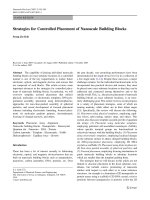Minerals building blocks of rocks
Bạn đang xem bản rút gọn của tài liệu. Xem và tải ngay bản đầy đủ của tài liệu tại đây (1.06 MB, 33 trang )
Minerals
Minerals: Building blocks of rocks
To be considered a mineral, a substance
must:
• be a naturally occurring solid
• be formed by inorganic processes
• have a crystalline structure (orderly
molecular arrangement)
• have a specific chemical composition
• An element is a substance that cannot be
broken down into simpler substances by
chemical means
• Minerals are made up of one or more elements
Most abundant elements of the
continental crust
• Common rockforming minerals are
mostly chemical
compounds made up
of these elements
• How do these
elements combine to
make minerals?
Atoms, molecules and ions
• Atoms are the smallest
individual particle that
retains the distinctive
chemical properties of an
element.
• Molecules are the smallest
individual particle that
retains the distinctive
chemical properties of a
chemical compound.
Molecules consists of 2 or
more atoms.
• Ions are atoms or
molecules that have a net
electrical charge. They
attract oppositely-charged
ions to form chemical
compounds.
Crystalline Nature of Minerals
• Crystal: any
substance whose
atoms are
arranged in a
regularly
repeating pattern
• Crystal growth is
often interrupted
due to:
– lack of space
– rapid cooling
rate
Luster: Appearance of a mineral in
reflected light
• Metallic (pyrite)
Nonmetallic: glassy/pearly
(potassium feldspar)
Luster: Appearance of a mineral in
reflected light
• Nonmetallic- waxy
(ex: chert)
• Nonmetallic –greasy
(quartz)
Color
• Often highly
variable for a
given mineral
due to slight
impurities in
crystal
structure
• For example,
quartz (SiO2)
exhibits a
variety of
colors
Other Physical properties of
minerals
• Streak
• Color of a mineral in its powdered form
• Helpful in distinguishing different forms
of the same mineral
• Hardness
• Resistance of a mineral to abrasion or
scratching
• All minerals are compared to a standard
scale, the Mohs Scale of Hardness.
Streak – the color of
a powdered mineral
Figure 2.10
Hardness
• Resistance of a
mineral to
abrasion or
scratching
• All minerals are
compared to a
standard scale
called the Mohs
scale of
hardness
Cleavage
• Tendency to break along planes of
weak bonding
• Produces flat, shiny surfaces
• Described by resulting geometric
shapes, and
– Number of planes
– Angles between adjacent planes
Three examples of perfect
cleavage – fluorite, halite,
and calcite
Copyright © 2006 Pearson Prentice Hall, Inc.
Common
cleavage
directions
Classification of Minerals
Rock-forming minerals
• Common minerals that make up most of
the rocks of Earth’s crust
• Only a few dozen members
• Composed mainly of the 8 elements that
make up over 98% of the continental
crust
8 most common elements
Classification of Minerals
• In most cases, minerals are grouped
according to the major “building
block” in the chemical structure.
• Silicates (SiO44-)
• Oxides (O22-)
• Sulfides (S2-)
• Sulfates (SO42- )
• Carbonates (CO32-)
• Halides (Cl1- , F1- Br1- )
• Native Elements (single element)
Rock-forming Minerals – The Silicate
Group
• Most common mineral
group due to large amounts
of silicon and oxygen in
Earth’s crust
• Basic building block is the
silicate ion: Four oxygen
ions surrounding a much
smaller silicon ion.
• Polymerization: process by
which silicate ions bond to
form more complex ions,
such as rings, chains,
sheets or 3 dimensional
frameworks.
Common Silicate minerals
• Olivine Group
/>
– High temperature Fe-Mg silicate
– Individual silicate linked together by iron and
magnesium ions
– Forms small, rounded crystals with no cleavage
Common Silicate minerals
• Pyroxene Group
/>
– Single chain structures involving iron and
magnesium
– Two distinctive cleavages at nearly 90 degrees
Common Silicate Minerals
• Amphibole Group
/>
– Double chain structures involving a variety of ions
linking the silicate ion
– Two perfect cleavages at non right angles
Hornblende is the most common mineral in the
amphibole group
Common Silicate Minerals
• Mica Group
/>
– Sheet structures that result in one direction of
perfect cleavage
– Biotite is the common dark colored mica.
Common Silicate Minerals
• Mica Group
/>
– Sheet structures that result in one direction of
perfect cleavage
– Muscovite is the common light colored mica.
Classification of Minerals
• Common Silicate minerals
• Feldspar Group
– Most common mineral group
– 3-dimensional framework that exhibits two
directions of cleavage at 90 degrees
– (potassium feldspar) (e.g. Orthoclase or
Microcline)
– Plagioclase (sodium and calcium feldspar)
are the two most common members









